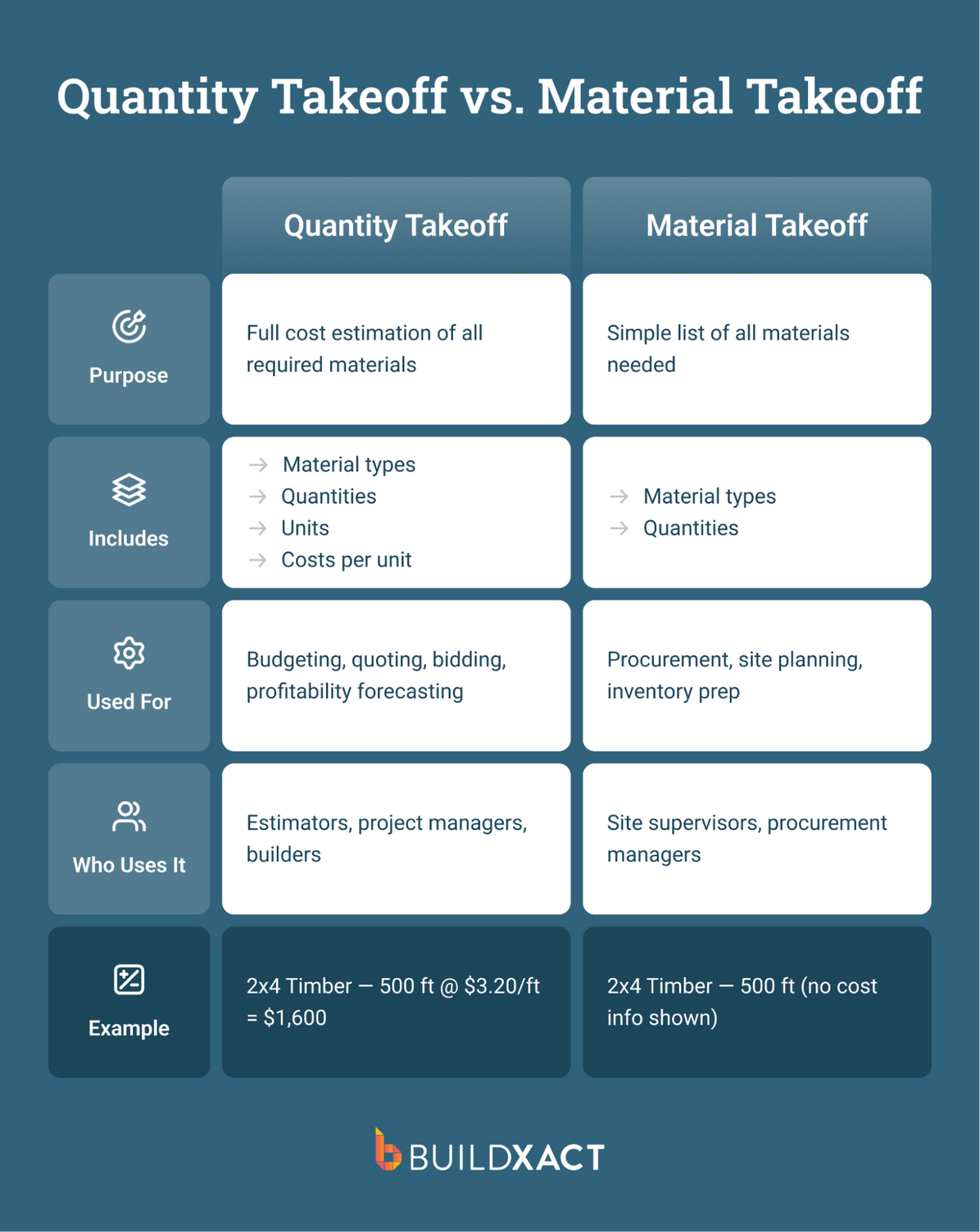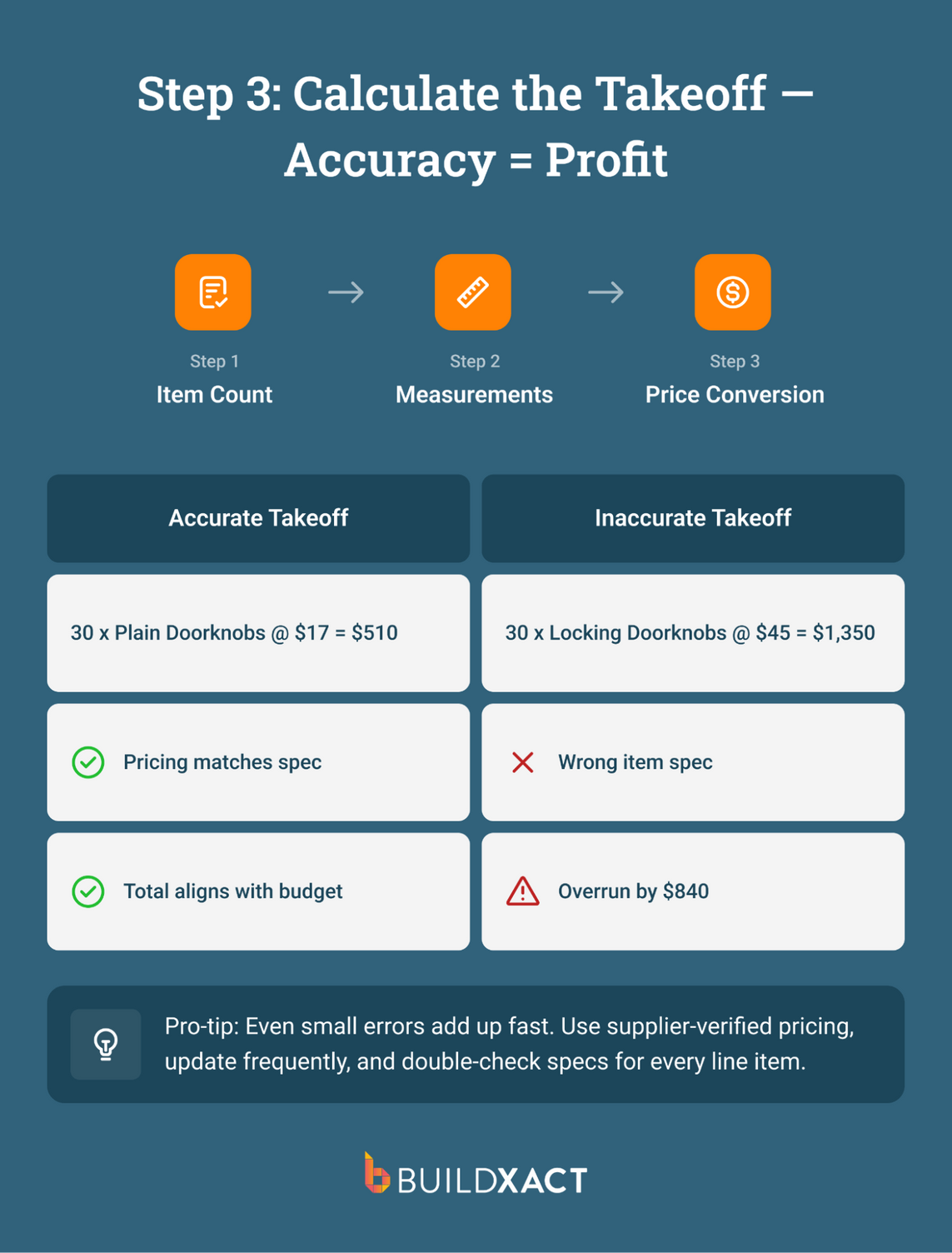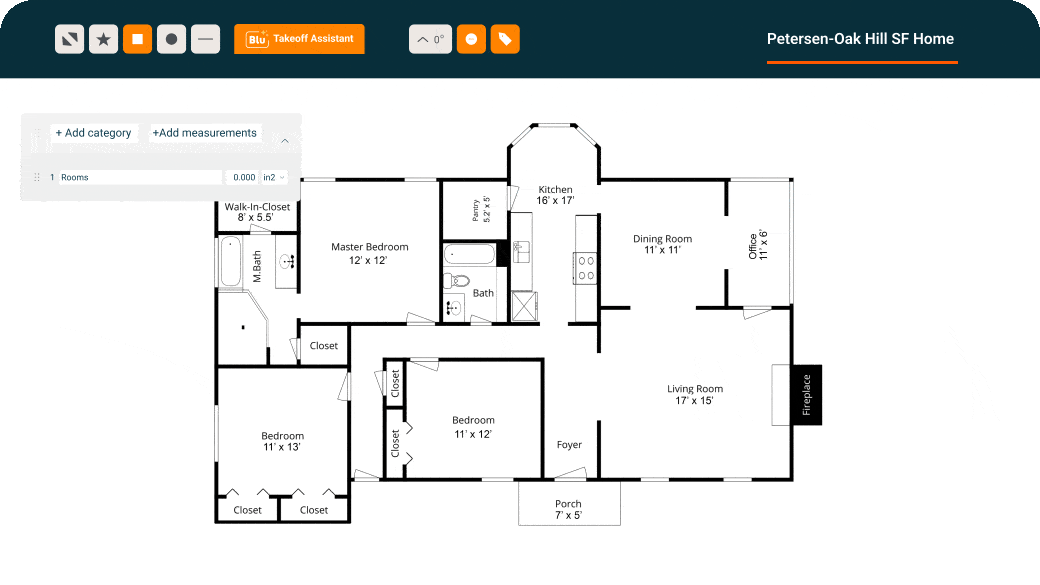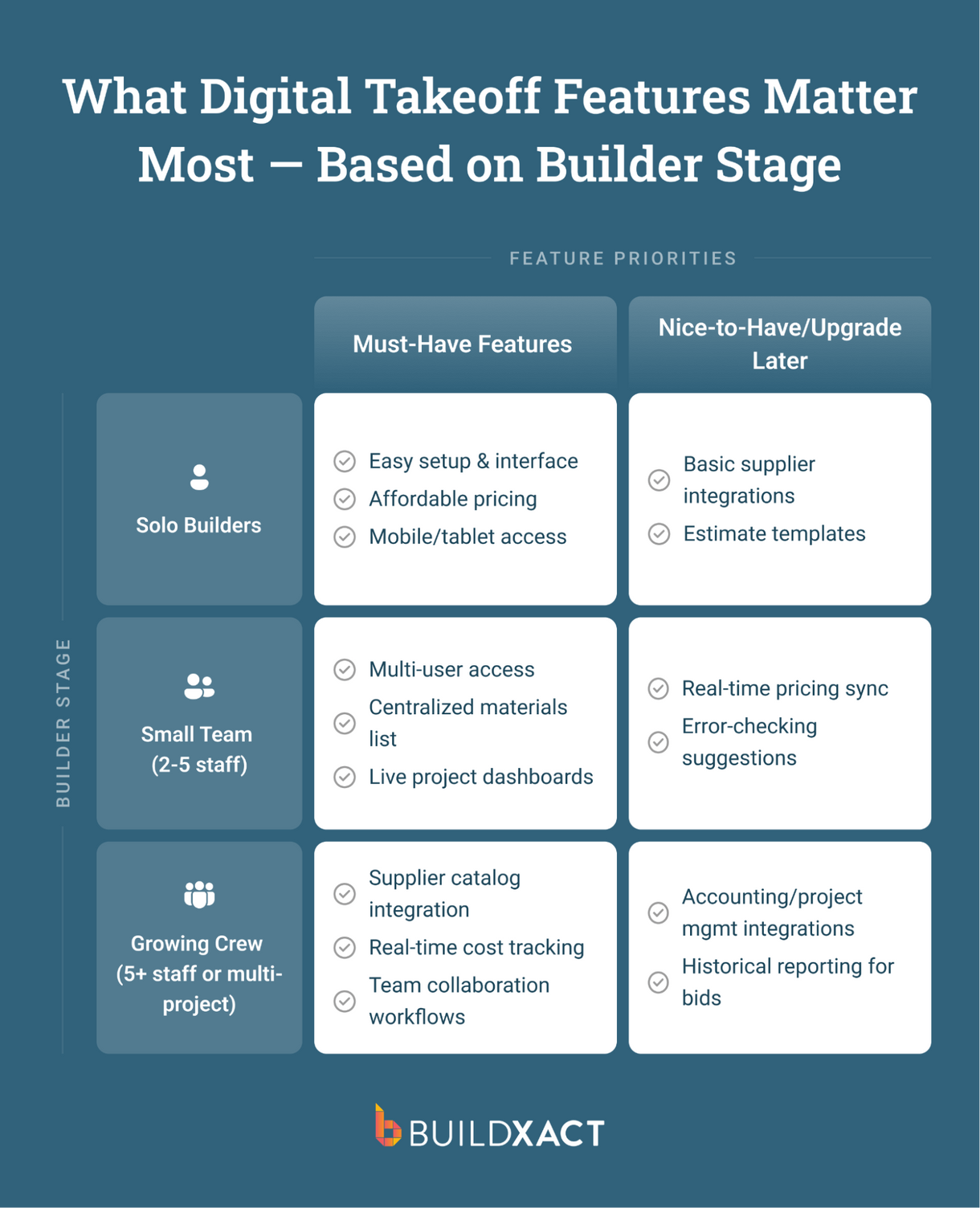When you lose a bid, it’s natural to assume you were simply undercut on price — a competitor out there offered more for less. But, you know what they say about assumptions, right?
With a robust portfolio of successful past projects and client testimonials singing your praises, the implication is clear: plenty of customers are willing to pay you for your work.
The question is whether you’re working fast enough to provide detailed quotes, complete with a full suite of information about materials, quantities, and costs, to potential customers before your competitor does.
In other words: Have you mastered your quantity takeoff process?
The good news is that solving the “speed vs completion” issue for quantity takeoffs is as simple as finding and using the right tools. Yet, the truth is that as many as 85% of construction professionals still use Excel for estimating and costing, even on complex projects.
There’s a way to be a part of the 15% of construction professionals who are putting themselves in the position to win with quantity takeoffs — and, in this guide, we’ll reveal how to achieve that, along with everything you need to know about quantity takeoffs, where the gaps are, and how to perform them using manual vs digital methods.
What Is a Quantity Takeoff — And Why It’s Crucial to Get It Right
In construction, a quantity takeoff refers to both an asset and an action:
- The asset: a list of all the physical material quantities necessary to complete a building project, along with their associated costs
- The action: when performing a quantity “takeoff,” what you’re doing is taking information off blueprints, drawings, or 3D models, and ‘quantity’ refers to the amount of material quantities.
Make a note of an important detail here: a quantity takeoff does not account for labor costs, permits, overhead, equipment, or other incidental expenses.
However, because it does involve a significant category of direct costs — namely, material quantities — an inaccurate quantity takeoff will throw off your estimate, and this is what determines whether you win profitable work or lose money on every job you land.
Inaccurate quantity takeoffs in construction — such as those that occur because you’re not working with real-time dealer pricing — mean you’re either padding your numbers to cover unknowns or underpricing and paying out of pocket for missed items. So, it’s crucial to your profit margins to get it right.
Quantity vs. materials takeoffs — what’s the difference?
The terms “material takeoff” and “quantity takeoff” are often used interchangeably, but there’s a key distinction:
- A material takeoff is simply an inventory list—it tells you what materials you need without measurements or pricing. Think of it as a shopping list.
- A quantity takeoff goes further. It includes every material, specifies the quantity of each (in units, linear length, surface area, cubic volume, or weight), and attaches costs.

For example:
- Material takeoff: “Lumber needed”
- Quantity takeoff: “Lumber: 120 linear feet at $4.50/ft = $540”
Every doorknob, floor tile, hinge, pipe, carpeting, length of steel, and fitting must be accounted for. Different materials require different measurements, but they can all be converted into a cost estimate.
When quantity takeoffs happen — and why timing matters
Quantity takeoffs occur during the pre-construction phase, after plans are available but before pricing is committed.
That window matters because:
“Too early,” and you’ll be working from incomplete plans.
“Too late,” and you’re either rushing through measurements or holding up your bid while competitors move ahead.
Anchoring the timing of a quantity takeoff to pre-construction gives you a reliable and discrete point because the phase itself is “early” in the overall building process as well.
So, conducting quantity takeoffs at this “early” phase in the process keeps you aligned. Additionally, offering quotes or bids without a completed quantity takeoff means you’re in the dark about whether your project budget allows for profit or sets you up for a loss. And for design-build or fast-track construction projects, quantity takeoffs often happen in phases rather than all at once.
Keep in mind that you’ll need to update your quantity takeoff several times as changes occur, ensuring you protect your margins and your clients are happy. A progressive and iterative approach to takeoffs enables you to adapt to an evolving project scope without compromising control over costs.
Who is responsible for a quantity takeoff?
Anyone in charge of a project that requires materials needs to perform a quantity takeoff. A baker calculates ingredient costs before quoting a wedding cake. In construction, the same principle applies, but the person handling it depends on the project’s size and complexity.
Here’s how responsibilities typically break down across the construction industry:
Estimators
- Run formal quantity takeoffs for competitive bids and larger projects
- Use specialized estimation software and detailed construction documents to ensure accuracy
Builders
- Often handle their own takeoffs on smaller residential jobs
- Work directly from plans to calculate material quantities and costs
Architects and engineers
- Create early-stage preconstruction estimates during the design phase
- Help clients understand the budget implications before finalizing plans

Most professionals rely on:
- Spreadsheets for organizing material lists and calculations
- Estimating software with built-in pricing databases
- Digital plan viewers for measuring from construction documents
- Dealer catalogs for current material costs
Key Components of Accurate Quantity Takeoffs
Construction projects demand significant time and investment. To remain profitable, you need to account for every cost in your pricing.
Without an accurate quantity takeoff, you face two equally damaging outcomes: overestimating material quantities prices you out of competitive bids, while underestimating leaves you covering the shortfall out of pocket, eroding your profit margin on jobs you win.
McKinsey research reveals that construction rework costs up to 20% of a project’s value, with planning and construction estimating errors contributing significantly to this waste.
For small and midsize builders, quantity takeoff mistakes consistently rank among the top causes of margin erosion. Each miscounted material compound across your project budget, turning what should be profitable work into break-even outcomes or losses.
How materials are measured in a quantity takeoff
Materials come in different forms, so suppliers price and sell them differently. You purchase lumber by the linear foot, concrete by the cubic yard, and flooring by the square foot.
Your quantity takeoff needs to match how suppliers sell these materials. That means you can’t count drywall sheets the same way you count doorknobs, and calculating carpet requirements differs entirely from measuring pipe lengths.

Understanding these measurement types ensures your material takeoff aligns with real-world purchasing and pricing. Here are the five standard measurement categories used in construction estimating:
Unit count
Items like lights, pipe fittings, hinges, doors, or power points are materials counted in units. With items like nails, a “unit” consists of 500 units, or a “unit” can refer to an individual object, such as an air conditioner or a window. Sometimes, the same item is available in different sizes, each with its own price. This means the items need to be tallied separately by size and cost group.
Linear length
Although you can count pipes, electrical wiring, or pieces of steel, vendors typically sell them according to length. So, you need to calculate the amount based on the linear length.
Surface area
To calculate the amount of material to cover an area, like carpet, the space’s length and width is multiplied to find the surface area. This process is used when taking off roof quantities.
Cubic volume
When filling space, such as with concrete or blown-in insulation, the measurements required are length, width, and height. This calculation will yield the cubic volume of the material, enabling you to estimate its cost accurately.
Physical weight
Materials like sand or backfill are measured by weight, such as a ton of sand. They are usually purchased in a standard amount, and an overestimation is needed to ensure enough quantity is ordered.
The Three-Step Process to Conducting a Quantity Takeoff
Preparing a quantity takeoff involves converting blueprints and construction documents into actionable data. You count the materials your project needs, measure them according to how suppliers sell them, and convert those quantities into costs for your project budget.
Step 1: Identify what needs to be counted
Before you can price out materials, you need a complete, organized list of everything your project requires. That means reviewing your plans, drawings, and specifications to identify every individual material, fixture, or product sold in countable units.
It’s not enough to know you need “roofing.” You need to know exactly how many boxes of nails, how many rolls of sarking, and how many sheets of corrugated steel.
Miss even one item, and the mistake will echo through your budget, purchasing, and scheduling. That’s why this first step sets the foundation for the accuracy of your entire takeoff.
Action items:
☐ Review all construction documents: floor plans, elevations, sections, and specifications.
☐ Create a master list of all materials sold, listing each item by count (e.g., units, boxes, fixtures).
☐ Include both major items (e.g., 12 doors) and smaller, often-overlooked components (e.g., three boxes of screws).
☐ Flag any items that require clarification or builder-specific change orders before proceeding to measurements.
Step 2: Take measurements
Materials like rebar, concrete, drywall, pipe, and timber aren’t counted one by one, but are measured by specific metrics. And because they’re priced and ordered by length, weight, area, or volume, your job is to calculate precisely how much you’ll need to cover the scope of work shown in your drawings.
Misjudging even a small area can lead to costly overages or delays. For example, underestimating drywall by just 100 square feet can mean a missed delivery deadline, crew downtime, and a frustrated client.
Action items:
☐ Identify materials that must be measured (e.g., cubic yards of concrete, square feet of flooring, linear feet of pipe).
☐ Use scale drawings or digital takeoff software to calculate exact quantities.
☐ Always match your measurements to the material’s standard size (e.g., drywall, sold by the box in 4×8 sheets).
☐ Add these measurements, along with their correct units, to your material takeoff list for accurate pricing.
Step 3: Calculate costs
Detailed descriptions and accurate pricing are crucial for a precise quantity takeoff. Buying 30 plain doorknobs at $17 each differs significantly from buying 30 locking doorknobs at $45 each. That single pricing error creates an $840 budget gap.
Multiply that across expensive materials or repeated oversights, and the financial impact compounds quickly.

Action items:
☐ Once your material quantity list is complete, convert the data into dollar amounts.
☐ Determine what each supplier charges per item, length, weight, or volume, then calculate total costs by quantity.
Manual vs Digital Quantity Takeoff
The choice between manual and digital takeoffs directly affects how fast you can bid and how accurate those bids are.
- Manual quantity takeoffs: a process requiring expertise and time, with any scope change resulting in restarting the measurement process.
- Digital quantity takeoffs: the same process is enabled and made efficient using tools that accelerate the process and reduce errors.
For construction projects where margins are tight and competition is fierce, understanding both approaches enables you to select the most suitable method for your business stage and project scope.
Manual quantity takeoff
Manual takeoffs rely entirely on the estimator’s or quantity surveyor’s knowledge and skill. They extract quantity takeoff data from drawings or blueprints, mentally converting 2D plans into 3D structures to calculate material quantities. This process demands both technical expertise and critical thinking.
The work is time-intensive when done with the detail and accuracy required for competitive bidding. Rush the process, and you risk missing materials or overlooking cost variables. Any miscalculation, whether in material counts, pricing, or quantity discounts, throws off your entire project budget.
Scope changes compound the challenge. Revising a manual material takeoff means recalculating measurements by hand, which adds significant time to an already labor-intensive process.
Digital quantity takeoff
Digital takeoffs use estimation software to streamline material calculations. You upload current price lists so costs stay accurate, and the software handles complex operations automatically.
The primary advantages are speed and precision. Digital quantity takeoffs take a fraction of the time that manual takeoffs require, all while reducing calculation errors.

Skilled operators still matter because they need to add accurate data, verify measurements, and catch errors that the home builder software might miss. However, AI-assisted quantity takeoff features detect, highlight for review, and contextualize errors, with recommendations on how to improve and address.
Choosing the Right Digital Quantity Takeoff Software For Your Team
Today’s digital takeoff solutions include AI assistants that analyze plans, identify potential measurement issues before they impact your bid, and use past project data to recommend material quantities.
These features help small home builders estimate more quickly without compromising accuracy, and assist growing builders in increasing bid volume without expanding their estimating team. For example, Buildxact’s AI assistant Blu delivers the speed of automation, cutting takeoff time by 80% and quoting customers 5x faster — all without sacrificing accuracy.

Buildxact’s takeoff functionality is designed to alert you to the most common estimating issues and errors early, pull live pricing from your suppliers, and adapt to your workflow, whether you’re handling a few bids or scaling up to dozens.
Takeoffs Powered by Technology, Not Tedium
Manual quantity takeoffs consume hours of your time, introduce calculation errors, and put your profit margins at risk with every bid. There’s a more innovative way to handle construction estimating.
Buildxact’s digital takeoff software eliminates the tedious manual calculations while improving accuracy. Upload your plans, let AI-powered tools handle the measurements, and generate professional bids in a fraction of the time it takes traditional methods to require.
Our platform integrates supplier pricing, catches common errors before they reach clients, and scales with your business. Start your 14-day free trial or book a demo today, and see how Buildxact helps you build smarter.














